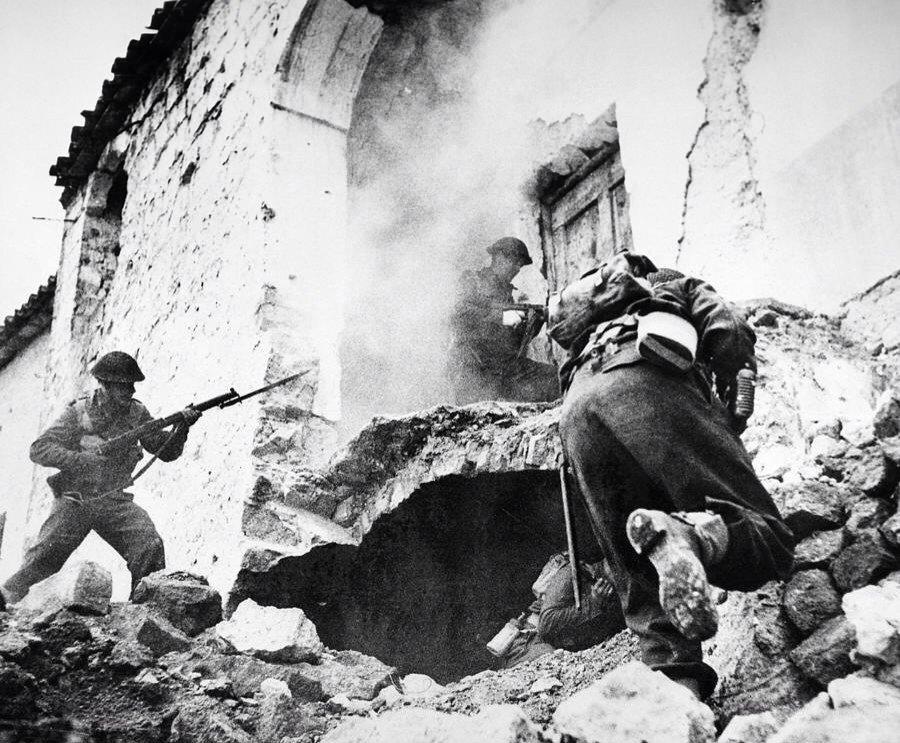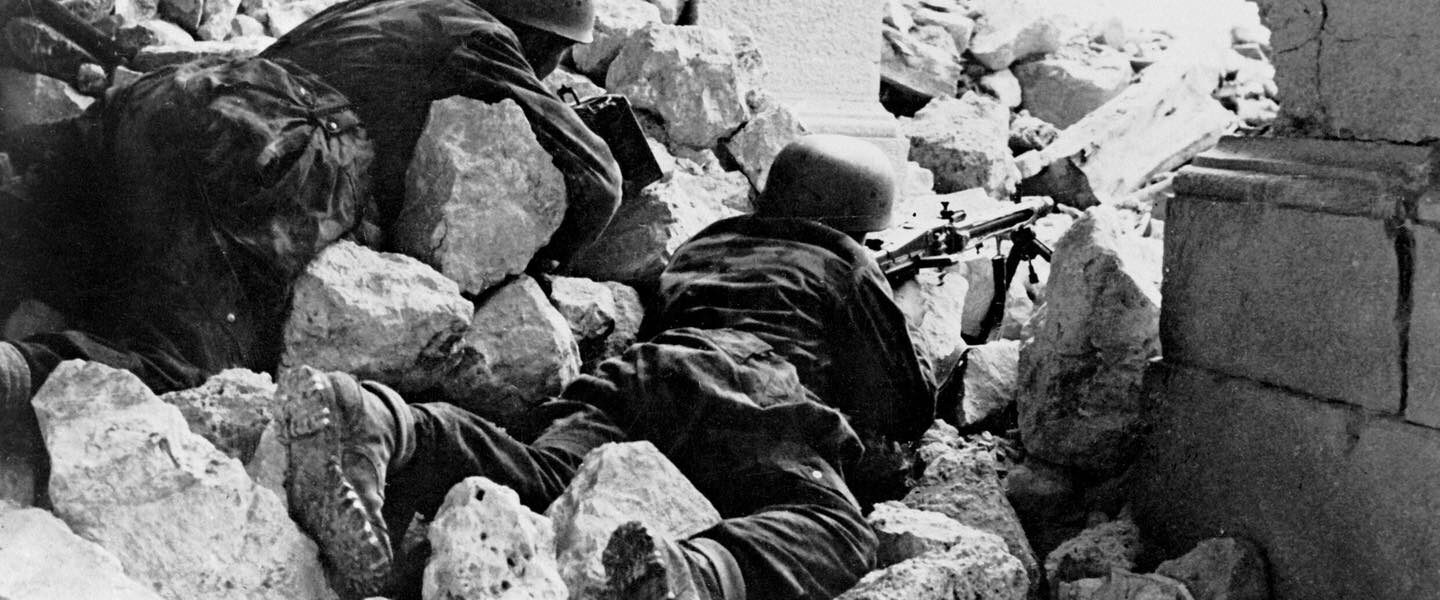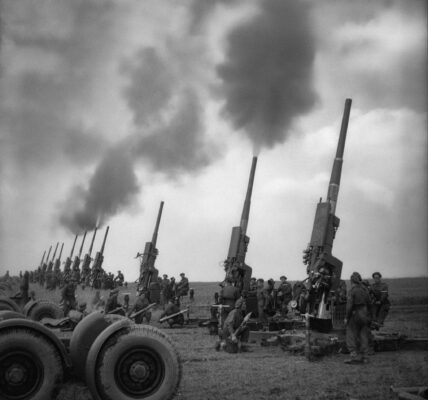- Homepage
- Uncategorized
- Monte Cassino, April 1944 – Deutsche Fallschirmjäger mit einem MG42 in den zerstörten Mauern des Klosters, wo einer der härtesten Kämpfe des Zweiten Weltkriegs tobte.H
Monte Cassino, April 1944 – Deutsche Fallschirmjäger mit einem MG42 in den zerstörten Mauern des Klosters, wo einer der härtesten Kämpfe des Zweiten Weltkriegs tobte.H
Monte Cassino, April 1944 – The Battle and the German Fallschirmjäger
The Battle of Monte Cassino, fought from January to May 1944, remains one of the most significant and grueling confrontations of World War II. Situated in central Italy, the Monte Cassino Abbey became the focal point of a series of bitter battles between the Allies and the Axis forces. Among the soldiers defending the Abbey were the German Fallschirmjäger (paratroopers), renowned for their combat prowess and often deployed in some of the most intense engagements. In April 1944, during the height of the battle, these elite soldiers were entrenched in the ruins of the Abbey, fighting one of the hardest and most costly battles of the entire war.

The backdrop of this intense combat was the strategic importance of the Monte Cassino position. The monastery, perched high on a hill, overlooked the Liri Valley, which was a critical route for the Allies advancing north from the beaches of southern Italy. The Allies, determined to break the German defense line, knew that capturing Monte Cassino was crucial for their success in pushing further into Italy. For the Germans, the Abbey held both military and symbolic significance. Not only did it provide a natural stronghold, but the monastery’s ancient history and religious importance made it a symbol of German resistance.

The destruction of Monte Cassino began in February 1944 when the Allies launched a massive bombing campaign, aimed at neutralizing the German defenses hidden within the ruins of the Abbey. The bombers dropped thousands of tons of explosives on the site, reducing the monastery to rubble. While the destruction of the Abbey was supposed to give the Allies an advantage, it ironically had the opposite effect. The ruins provided new defensive positions for the German paratroopers, who were stationed there. The Germans had anticipated the attack, and their highly trained Fallschirmjäger troops were ready to repel any assault.

The MG42 machine gun, one of the most fearsome weapons of the German forces during the war, played a crucial role in the defense of Monte Cassino. This rapid-fire weapon was capable of delivering a constant barrage of bullets, making it an ideal tool for holding off advancing infantry. In the hands of skilled German paratroopers, the MG42 turned the ruins of Monte Cassino into a deadly killing ground. As the Allies mounted wave after wave of attacks on the German positions, the Fallschirmjäger proved to be formidable opponents, inflicting heavy casualties and slowing the Allied advance.

The battle itself was a brutal affair, characterized by trench warfare, close-quarters combat, and the constant threat of artillery and aerial bombardment. The terrain, with its rocky slopes and dense vegetation, created difficult conditions for both sides. The Allies, despite their overwhelming superiority in numbers and firepower, found it increasingly difficult to breach the German defenses. The German Fallschirmjäger, with their disciplined tactics and knowledge of the terrain, fought with relentless determination, making any progress costly for the Allies.
By April 1944, the battle had become a brutal stalemate. The Allies had launched multiple offensives, but each attempt to break through the German defenses was repelled. The fighting had reached a fever pitch, with both sides suffering heavy losses. For the Germans, the Fallschirmjäger had earned a reputation as some of the most capable soldiers on the battlefield. Their experience in airborne operations, combined with their tenacity in holding their ground, made them an ideal force for defending the strategically vital Monte Cassino.
The image of German Fallschirmjäger armed with the MG42 amidst the ruins of Monte Cassino captures the essence of the battle. It is a symbol of the desperation and determination that defined the fighting on both sides. The Fallschirmjäger, fully equipped and entrenched in the rubble, appear as a deadly force, expertly using the ruins as cover and maximizing the effectiveness of their weapons. The MG42, with its distinctive rapid-fire sound, would have been a constant presence in the background, further intensifying the grim reality of the battle.
Despite the fierce German resistance, the Allies eventually managed to break through Monte Cassino in mid-May 1944, but at great cost. Thousands of soldiers, both Allied and German, had perished in the battle, and the landscape was scarred by the devastation of war. The fall of Monte Cassino paved the way for the Allies’ subsequent advance into northern Italy, but it also marked the end of one of the war’s most devastating and costly campaigns.
In retrospect, the Battle of Monte Cassino stands as a testament to the courage and determination of the soldiers who fought there. The German Fallschirmjäger, with their elite training and fierce resolve, played a significant role in defending the Abbey and delaying the Allied advance. Their presence in the ruins of Monte Cassino, armed with the fearsome MG42, remains one of the iconic images of the battle. The destruction of the Abbey, while symbolizing the brutal cost of war, also underscores the resilience of the human spirit in the face of overwhelming odds.
In conclusion, the Battle of Monte Cassino was not just a clash of armies but a clash of ideologies, strategies, and human endurance. The German Fallschirmjäger, with their skillful use of the MG42 and their mastery of defensive warfare, were pivotal in making Monte Cassino one of the most grueling battles of World War II. The images of these soldiers amidst the ruins of the Abbey serve as a stark reminder of the sacrifices made by all who fought in this battle and the destruction that war leaves in its wake.

